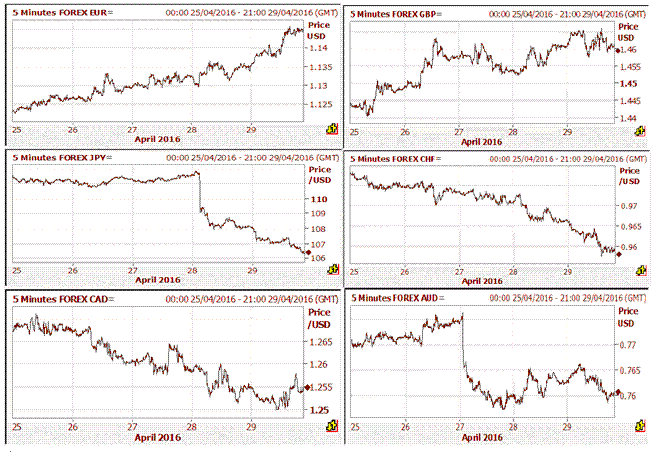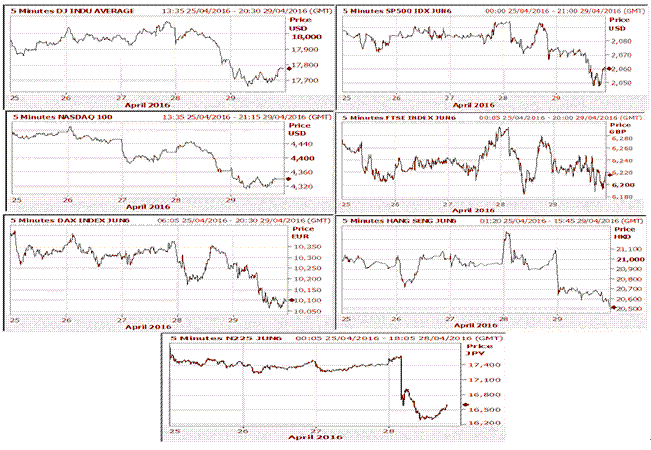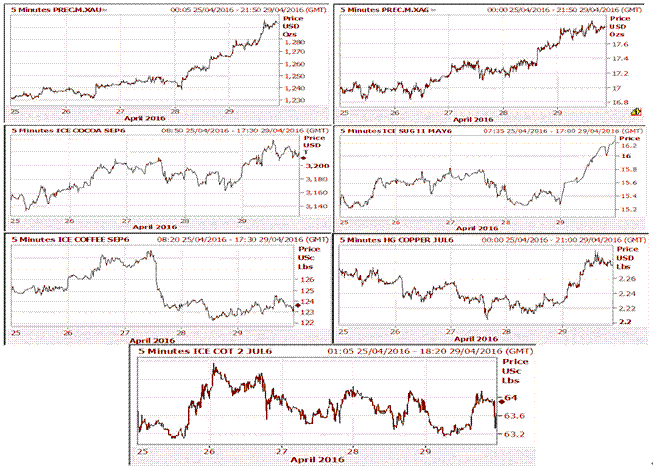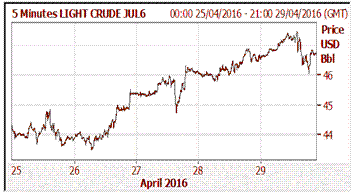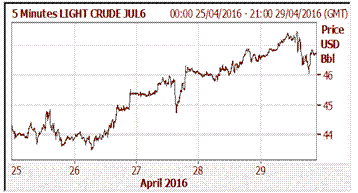FOREX
Forex – The U.S. dollar slipped against the yen on Monday as traders took profits from the greenback's recent rally against the Japanese currency, while the dollar weakened against other major currencies on expectations for a dovish Federal Reserve meeting. The dollar hit a session low after reaching a more than three-week high. Analysts said traders were taking profits and selling the dollar despite expectations that the Bank of Japan could increase its stimulus measures on Thursday after a policy meeting. While the BOJ could increase stimulus, analysts said skepticism that such an increase could weaken the yen lifted the Japanese currency against the dollar.
The U.S. dollar was modestly weaker against most major currencies on Wednesday on expectations the Federal Reserve would strike a dovish tone in an afternoon policy statement, while the risk of a hawkish shift mitigated losses. The Euro was last up 0.2 percent against the dollar ahead of the scheduled (1800 GMT) release of the statement from the U.S. central bank's interest rate-setting committee. The dollar was also down 0.09 percent against the yen. The Fed is expected to leave rates unchanged as it continues to monitor the impact from weakening global growth, but some analysts said the central bank could alter its language to highlight reduced global risks.
The U.S. dollar was on track for its biggest weekly percentage decline against the yen since the 2008 financial crisis in the aftermath of the Bank of Japan's decision not to ease policy further, while strong Euro zone growth data boosted the Euro. The dollar was last down 0.69 percent against the yen on Friday after hitting an 18-month low. The dollar was last down about 4 percent against the yen for the week, putting it on track for its biggest weekly loss since October 2008.Draghi said the central bank's policy of printing money and keeping borrowing costs at rock bottom was working, adding that interest rates would stay at current record lows for a long time.
INDICES
Indices - World stocks, the dollar and oil all fell modestly on Monday as investors locked in recent gains before central bank meetings in the United States and Japan this week. European and Asian equities both sank as 3.2 and 1.2 percent falls for miners. Signs that a three-month rally in stocks and commodities markets was cooling, a U.S. Federal Reserve rate decision on Wednesday and a Bank of Japan policy update on Thursday meant there was little incentive for traders to be bold. Talk has been that Japan could push deeper into negative interest rate territory, while there is intense interest on where the Fed currently stands on another rate hike.
Wall Street stocks were steady, U.S Treasury debt yields fell sharply, and oil prices rose to their highest level of the year on Wednesday after the Federal Reserve announced it would keep U.S. interest rates unchanged. The Fed left their policy interest rate target at the previous level of 0.25 percent to 0.5 percent as expected, and while it left the door open to a rate rise in June, its statement implied that it was in no hurry to follow on from its December rate rise. The statement helped U.S. stocks recover some early losses, lowered long term bond yields and boosted crude oil prices.
The yen hit an 18-month high on Friday as investors bet the Bank of Japan might be done adding stimulus to the economy, while stocks in Europe and on Wall Street headed lower as earnings disappointed. Major European stock indexes closed down more than 2 percent, but U.S. equities pared some losses by the close after being down as much as 1 percent. The yen posted its biggest weekly gain since the 2008 financial crisis, also spurred by a weak reading of U.S. economic growth in the first quarter on Thursday and the Federal Reserve's cautious tone this week.
COMMODITIES
Commodities - Gold rose on Monday as a retreat in the U.S. dollar helped to tempt back some buyers after the previous session's 1.3 percent slide, but moves were muted ahead of a Federal Reserve policy meeting this week. The Fed is not expected to raise interest rates at its April 26-27 meeting, but markets will be looking for the U.S. central bank's take on the global economy and its monetary policy outlook. Gold rose for a third straight session on Wednesday, but pared gains after the U.S. Federal Reserve held interest rates unchanged but left the door ajar to a hike in June. The U.S. central bank's policy-setting committee said the labour market had improved further despite a recent economic slowdown and that it was keeping a close eye on inflation. Gold rallied 2 percent to their highest since January last year on Friday as the Bank of Japan's decision the previous day to hold off expanding monetary stimulus weighed heavily on the dollar, and European and U.S. stocks fell. The yen hit an 18-month peak versus the U.S. currency and was on course for its biggest weekly gain since the 2008 financial crisis, with poor U.S. growth and the Federal Reserve's cautious stance this week weighing on the dollar.
Sugar rallied 3 percent on Monday, nearing the prior session's three-week high, as prolonged dryness in top grower Brazil raised concern despite expectations the country's cane industry data will show a brisk crush. Cocoa futures were mixed after extending gains to multi-month highs on expectations for lower output in West Africa, while coffee firmed on lower than normal yields as Brazil's harvest begins. Sugar fell more than 2 percent on Wednesday, extending losses after cane data from top grower Brazil showed a record cane crush at the high end of expectations for the first half of April. Coffee dropped sharply to a four-week low, pressured by broad-based selling as the 19-market Thomson Reuters Core Commodity Index turned negative ahead of a policy statement by the U.S. Federal Reserve as a two-day meeting concludes. Sugar rose on Friday buoyed by a weaker dollar as traders focused on a likely modest delivery against expiry of the May contract, while cocoa traded near 2016 highs, with the market viewed as overbought. Coffee edged higher, underpinned by concerns over a poor Brazilian harvest, due to prolonged dry weather.
ENERGY
Crude Oil - Oil prices fell more than 2 percent on Monday as data pointed to fresh U.S. crude builds, while leading banks in commodities said the two-month long oil market rebound has defied fundamentals. A Reuters poll forecast a nationwide U.S. crude build of 2.3 million barrels last week, a third straight week of such builds. Market intelligence firm Genscape reported that stockpiles at the Cushing, Oklahoma delivery point alone rose by over 1.5 million barrels in the week to April 22nd.
Oil prices jumped about 3 percent on Wednesday, hitting new highs for 2016 as the dollar weakened after the Federal Reserve announced it would leave U.S. interest rates unchanged. Oil had risen early, the day after an industry group said U.S. crude inventories had dropped in the latest week. But prices retreated after the U.S. Energy Information Administration reported in the morning that crude stocks climbed 2 million barrels last week to an all-time peak of 540.6 million barrels.
Oil prices ended steady on Friday after hitting 2016 highs but finished April trading about 20 percent higher, with Brent crude having its best monthly gain in seven years. A weaker dollar and optimism that a global oil glut will ease have lifted crude futures by more than expected since they plumbed to 12-year lows in the first quarter. Brent futures settled just a penny lower per barrel, after reaching a 2016 peak. It rose 21.5 percent in April, its largest monthly advance since May 2009.
Natural Gas - U.S. natural gas futures fell nearly 4 percent on Monday, retreating from two-month highs earlier in the day, on forecasts for slightly warmer-than-usual weather. Front-month natural gas futures on the New York Mercantile Exchange settled down 3.6 percent per million British thermal units. Both U.S. and European weather models point to slightly above-normal temperatures over the next two weeks, expected to keep heating demand in check for this time of year.
U.S. natural gas futures fell nearly 2 percent on Wednesday, losing ground for a third straight session on expectations of lower heating and cooling demand due to forecasts for near-normal temperatures over the next two weeks. On its last day of trading, May gas futures on the New York Mercantile Exchange settled down 1.8 percent per million British thermal units. It has fallen nearly 6.8 percent so far this week. U.S. utilities were expected to inject 70 billion cubic feet of natural gas into storage in the week ended April 22 on lower demand for heating, a Reuter’s survey of energy analysts showed on Wednesday.
U.S. natural gas futures rose about 5.0 percent to near three-month highs on Friday, helped by increased usage by the power sector amid persistent production declines. Front-month natural gas futures on the New York Mercantile Exchange NGc1 settled 4.8 percent per million British thermal units. With stockpiles at record highs after a warm winter, analysts said gas prices would have to remain low through 2016, which could lead to more production cuts and encourage power generators to keep burning gas instead of coal. The U.S. power sector has burned about 24.1 billion cubic feet a day so far this year, up from 22.9 bcfd a year earlier, according to Thomson Reuters Analytics. Power generators used record-high amounts of gas in 2015 and were expected to use even more this year, according to federal estimates.
The information set forth herein was obtained from sources which we believe to be reliable, but its accuracy cannot be guaranteed. It is not intended to be an offer, or the solicitation of any offer, to buy or sell the products or instruments referred herein. Any person placing reliance on this commentary to undertake trading does so entirely at their own risk.
Recommended Content
Editors’ Picks
AUD/USD risks a deeper drop in the short term

AUD/USD rapidly left behind Wednesday’s decent advance and resumed its downward trend on the back of the intense buying pressure in the greenback, while mixed results from the domestic labour market report failed to lend support to AUD.
EUR/USD leaves the door open to a decline to 1.0600

A decent comeback in the Greenback lured sellers back into the market, motivating EUR/USD to give away the earlier advance to weekly tops around 1.0690 and shift its attention to a potential revisit of the 1.0600 neighbourhood instead.
Gold is closely monitoring geopolitics

Gold trades in positive territory above $2,380 on Thursday. Although the benchmark 10-year US Treasury bond yield holds steady following upbeat US data, XAU/USD continues to stretch higher on growing fears over a deepening conflict in the Middle East.
Bitcoin price shows strength as IMF attests to spread and intensity of BTC transactions ahead of halving

Bitcoin (BTC) price is borderline strong and weak with the brunt of the weakness being felt by altcoins. Regarding strength, it continues to close above the $60,000 threshold for seven weeks in a row.
Is the Biden administration trying to destroy the Dollar?

Confidence in Western financial markets has already been shaken enough by the 20% devaluation of the dollar over the last few years. But now the European Commission wants to hand Ukraine $300 billion seized from Russia.
